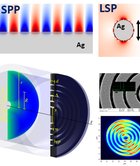
Plasmonics is a new field of science at the interface of optics and solid-state physics, that studies and uses the phenomenon of Surface Plasmon Resonance, occurring as a result of the excitation of collective charge oscillations on the surface of a conductor. As a result, at the metal-dielectric interface, a surface electromagnetic wave (surface plasmon-polariton) appears, showing a strong amplification of the electromagnetic field and its localization at the metal surface, where the penetration depth in the dielectric medium is shorter than the wavelength.
The special properties of surface plasmons-polaritons and the development of methods for the fabrication of metallic nanostructures allowed the emergence of new research directions and the development of new systems of great cognitive and application significance applicable in such fields of knowledge as telecommunications, medicine or technologies using renewable energy sources.
Our research group focus is the design, modeling, fabrication, and characterization of plasmonic nanostructures, as well as the development of new techniques for the fabrication and characterization of these nanostructures for applications in such fields as photonics, photovoltaics, biosensors, and others.
The most important achievements of the group include the development of fabrication technology of ultra-smooth silver layers for applications in plasmonic systems and high-resolution probes for scanning near-field microscopy (SNOM). The results of this work were published in the following articles:
1. Munkhbat B., Wróbel P., Antosiewicz T.J., Shegai T., 2022, Optical constants of several multilayer transition metal dichalcogenides measured by spectroscopic ellipsometry in the 300-1700 nm range: high-index, anisotropy, and hyperbolicity, ACS Photonics, vol. 9(7), 2398–2407, 10.1021/acsphotonics.2c00433
2. Rácz P., Pápa Z., Márton I., Budai J., Wróbel P., Stefaniuk T., Prietl C., Krenn J.R., and Dombi P., 2017: Measurement of Nanoplasmonic Field Enhancement with Ultrafast Photoemission, Nano Letters, vol. 17 (2) , pp. 1181–1186 , 10.1021/acs.nanolett.6b04893
3. Wróbel P., Stefaniuk T., Trzcinski M., Wronkowska A.A., Wronkowski A., Szoplik T., 2015: Ge wetting layer increases ohmic plasmon losses in ag film due to segregation, ACS Applied Materials & Interfaces, vol. 7 (17) , pp. 8999–9005 , 10.1021/acsami.5b01471
4. Wróbel P., Stefaniuk T., Antosiewicz T.J., Libura A., Nowak G., Wejrzanowski T., Andrzejczuk M., Kurzydłowski K.J., Jedrzejewski K., and Szoplik T., 2012: Fabrication of corrugated Ge-doped silica fibers, Optics Express, vol. 20 (13) , pp. 14508-14513 , 10.1364/OE.20.014508
Currently, we are working on:
• studies of the influence of material and structural properties of nanostructures on the excitation efficiency of plasmonic resonance,
• reduction of losses in plasmonic systems,
• designing sensitive nanostructures for applications in plasmonic biosensors, including surface-enhanced Raman spectroscopy (SERS).
• application of plasmonic effects to improve the efficiency of solar cells,
• design of hybrid plexcitonic systems for studying strong light-matter interactions.
